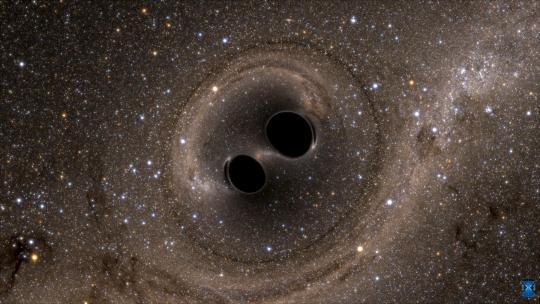
Eda Yu on the Use of Gravity in Pop Culture
One point three billion light years away, two black holes collide. Both are around 30 times the mass of the sun, neither small nor supermassive, but these two black holes are, like all black holes, a prodigious kind of death: collapsed stars that are only able to be seen through the movement of their still-shining celestial counterparts. When they collide, they generate the most energetic event observed in the universe, changing the distance between the Earth and the sun by the width of a single atom. They also generate the first gravitational waves ever to be detected.
The popular conception of gravity is as a force that acts on us, an inescapable entity over which we have no control. But last September, when the Laser Interferometer Gravitational-Wave Observatory (LIGO) collaborators detected gravitational waves, they confirmed the stunning malleability of space-time and the true role gravity plays in describing our universe’s celestial blanket of time and space. It seems we’ve been thinking about gravity all wrong.
Although we tend to think of time and space as constants, they are actually dynamic variables—elements that are constantly in flux, depending on the energy content of the universe. We are, in a sense, able to affect time and space as much as they are able to affect us. Contrary to popular belief, time does not simply progress in a linear fashion; instead, it encircles us, perhaps even giving way to the strength of our small bits of substance. As space-time yields to mass, curving snugly around matter, gravity measures that curve.
“A gravitational wave is a bending of space-time itself,” says Meg Millhouse, a PhD student at Montana State University and a member of the LIGO collaboration. In theory, gravitational waves are created when masses move and disturb space-time; a common example scientists employ is “a sheet of rubber” to represent space-time “and a bowling ball in the middle” to represent gravity.
The observation of gravitational waves has far-reaching, potent consequences, opening doors for further scientific advancements and fields of study, in addition to more comprehensively proving Einstein’s Theory of General Relativity. “The analogy [scientists] like to use a lot is that we’re now listening to the universe. It’s a totally different wave band, different spectrum. Before, we could only see the universe; now we can hear it, too,” Millhouse says.
The observation of gravitational waves has brought us a step closer to celestial enlightenment, but is this enormously powerful force even the same gravity we thought we knew? In pop culture, gravity is often portrayed as a force that draws us to a romantic interest against our will. In Muse’s “Supermassive Black Hole,” the band’s lead singer blames gravity for his inability to escape a bad relationship, referring to himself as one of “the superstars sucked into the supermassive.” Similarly, Sara Bareilles sings, in her song “Gravity,” “Set me free / Leave me be / I don’t want to fall another moment into your gravity.”
Another popular theme is gravity’s ability to weigh us down, both physically and metaphorically: gravity as a force to which we invariably succumb. In John Mayer’s “Gravity,” the singer laments that “Gravity is working against me / and gravity wants to bring me down.” Coldplay, in their song “Gravity,” also sing of “the way that gravity pulls on you” and “the way gravity pushes on everyone.”
Instead of appreciating it for the strong nuclear force it is, these songs incorrectly belittle gravity by using it as a scapegoat for human failure—even going so far as to paint it as a malicious, petty entity that aims to bring us down.
Inception, Christopher Nolan’s popular sci-fi thriller, comes a step closer to getting gravity right. The film’s characters possess “totems,” objects that help determine whether one is in a dream state or reality depending on whether or not they obey gravity. This system acknowledges the force as a constant in our universe, one that must exist no matter how the environment around us changes. As Millhouse puts it, “Time is not the same everywhere in the universe; space is not the same everywhere in the universe. [But] gravity… is always the same.”
Nolan’s Interstellar does an even better job of introducing “weird gravity effects to the general public,” in Millhouse’s words. The film plays on the idea that, no matter how small the forces we create seem, we are capable of having a sizable impact on the universe. The film’s protagonist, Murph, exemplifies this idea by “solving gravity.” She realizes that they had been wrong in assuming gravity, as Newton’s numerical constant, was absolute. Instead, the bond she created with her father was strong enough to transcend time and space and ultimately reset gravity to apply to a different planet.
With this approach, Interstellar might be the first work of art yet to laud gravity for its pivotal role in governing our universe. (This is perhaps thanks to the fact that Kip Thorne, a cofounder of the LIGO project, worked as an adviser on the film.) For Millhouse, the film “opened up a lot of really good conversation about what gravity does, and what black holes look like” and led people to ask questions like “what would happen if I fell through a black hole?” It began to shift the way people think about gravity—and, perhaps, the way we think about ourselves.
One point three billion light years away, two black holes collided. Now, Millhouse says, “We’re opening up a whole new window into the universe. We’ll be able to use gravity to see stuff out there rather than just thinking about it.” We are hoping to see the unseen.
“I mean,” Millhouse laughs. “We already have.”




